|
|
|
Sort Order |
|
|
|
Items / Page
|
|
|
|
|
|
|
| Srl | Item |
| 1 |
ID:
103650
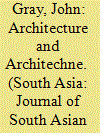

|
|
|
|
|
| Publication |
2011.
|
| Summary/Abstract |
In this paper I identify the doubleness of domestic space-not just as architecture, that is, the production of houses that expresses social reality, cultural meanings and/or cosmology, but also as architechnemacr, that is, as the embodied experience, tacit knowledge and revelation produced by everyday living in domestic space. This distinction provides the framework for analysing Nepali houses as domestic mandalas. I argue that in the taken-for-granted, everyday use of domestic space as architechnemacr, Nepalis engage in an embodied bringing forth of their houses as an enframing whole, as a structure of revealing of the cosmos and the nature of their lifeworld as Householders.
|
|
|
|
|
|
|
|
|
|
|
|
|
|
|
|
| 2 |
ID:
103651


|
|
|
|
|
| Publication |
2011.
|
| Summary/Abstract |
This article is a study of the Australian government's policy of not selling uranium to India. Successive Australian governments have used the Nuclear Non-Proliferation Treaty (NPT) to refuse India's repeated requests for uranium. This study looks at the Indian response to this policy and asks how long Australia can sustain its stand in the face of climate change, economic growth and growing bilateral relations between two democracies with shared interests.
|
|
|
|
|
|
|
|
|
|
|
|
|
|
|
|
| 3 |
ID:
103648
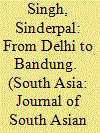

|
|
|
|
|
| Publication |
2011.
|
| Summary/Abstract |
The idea of 'Asia', as a distinct space in international politics, has generated a good deal of historical and contemporary debate. This article seeks to engage this debate by examining how the Indian state, under its first prime minister and external affairs minister, Jawaharlal Nehru, attempted to delineate certain Pan-Asian regional identities at both the 1947 Asian Relations Conference in Delhi and the 1955 Afro-Asian Conference in Bandung. It will argue that such articulations of specific Pan-Asian identities were linked to the manner in which Nehru sought to represent certain aspects of the Indian state during this period.
|
|
|
|
|
|
|
|
|
|
|
|
|
|
|
|
| 4 |
ID:
103649
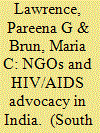

|
|
|
|
|
| Publication |
2011.
|
| Summary/Abstract |
India has the second-largest population living with HIV/AIDS in the world. Although the exact number of HIV positive people is contested, it is predicted that the current numbers are likely to grow at a rapid rate in the next decade if the epidemic goes unchecked. This paper explores the HIV/AIDS epidemic in India through the perspective of two non-governmental organisations (NGOs) whose roles have become critical in the fight against the disease. Specifically, it identifies the challenges faced by these NGOs such as lack of government responsiveness, funding-related problems, corruption, donor accountability, and cultural attitudes to HIV/AIDS, while exploring the theoretical implications of NGOs playing a greater role in providing programming and services to those living with, and affected by, the epidemic.
|
|
|
|
|
|
|
|
|
|
|
|
|
|
|
|
| 5 |
ID:
103646
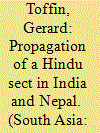

|
|
|
|
|
| Publication |
2011.
|
| Summary/Abstract |
The Krishna-PraCSAS_A_549082_O_XML_IMAGES/CSAS_A_549082_O_ILF0001.gifamacrmi-sampradamacry is a Hindu non-caste reformist sect belonging to the bhakti and sant streams. It originated in seventeenth-century Gujarat and rejects life-cycle rituals and sacrificial rites. Its expansion over the last decades in Nepal and Northeast India has been a remarkable phenomenon. This article examines the historical propagation of the congregation. In the past, the influence of charismatic religious figures prevailed; today, teaching by young preachers and the use of new means of communication, especially through mega-ceremonies of the pamacrramacryaCSAS_A_549082_O_XML_IMAGES/CSAS_A_549082_O_ILF0009.gif type, play a major role. This development has led to internal conflicts. A dissenting minority advocates a return to the original nirgun (formless, devoid of qualities) ideas of the group.
|
|
|
|
|
|
|
|
|
|
|
|
|
|
|
|
| 6 |
ID:
103647
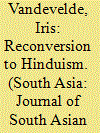

|
|
|
|
|
| Publication |
2011.
|
| Summary/Abstract |
From the broader debate on the phenomenon of conversion, it becomes clear that conversion to Christianity and Islam generates discomfort in Indian society. Moreover reconversion to Hinduism, which often goes unnoticed in this controversy, also exists. What kinds of phenomena are labelled as reconversion? What meanings do they have? Based on fieldwork and interviews, alongside analyses of media coverage and archival research, this article gives an overview of the different kinds of reconversion from the end of the nineteenth century up to the present and analyses its conceptualisation by both its critics and its promoters. From these analyses follows the conclusion that reconversion is mainly a tool to arrest Christian and Muslim conversions.
|
|
|
|
|
|
|
|
|
|
|
|
|
|
|
|
|
|
|
|
|